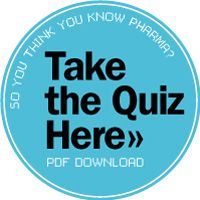How Much Do You Really Know About Pharma: Quiz Answers
Find out how you did on our December 2005 quiz.
ANSWERS:
1. The African clawed frog (Xenopus laevis)
2. The researchers rubbed spores of the Penicillium mold into the fabric of their lab coats.
3. Asprin (acetylsalicylic acid)
4. Travelers were to bring back soil samples from the locations they visited. The soil fungus from which Cyclosporine was derived was collected in Norway.
5. Hoffman acetylated morphine, creating heroin.
6. Actually, there were two, Robert Wood Johnson’s brothers James and Edward Mead.
7. Tetracycline
8. Vitamin C (ascorbic acid)
9. “It has not escaped our notice . . .” comes from Watson and Crick’s 1953 Nature article on the structure of DNA. What hadn’t escaped their notice was the fact that the double helix structure they proposed suggested possible copying mechanism for genetic material.
10. Perkins, then 18, was trying to create a synthetic form of quinine.
11. Microbiologist and Nobel Prize winner Selman Waksman discovered streptomycin.
12. Photographer Janet Parker, the world’s last victim of smallpox, died. She apparently was infected by virus that escaped from a laboratory containment.
13. The odd company out is Neutrogena, which is owned by Johnson & Johnson. The rest are part of Pfizer.
14. Sudafed (pseudoephedrine)
15. The Wisconsin Alumni Research Foundation

Addressing Disparities in Psoriasis Trials: Takeda's Strategies for Inclusivity in Clinical Research
April 14th 2025LaShell Robinson, Head of Global Feasibility and Trial Equity at Takeda, speaks about the company's strategies to engage patients in underrepresented populations in its phase III psoriasis trials.
Beyond the Prescription: Pharma's Role in Digital Health Conversations
April 1st 2025Join us for an insightful conversation with Jennifer Harakal, Head of Regulatory Affairs at Canopy Life Sciences, as we unpack the evolving intersection of social media and healthcare decisions. Discover how pharmaceutical companies can navigate regulatory challenges while meaningfully engaging with consumers in digital spaces. Jennifer shares expert strategies for responsible marketing, working with influencers, and creating educational content that bridges the gap between patients and healthcare providers. A must-listen for pharma marketers looking to build trust and compliance in today's social media landscape.

.png&w=3840&q=75)

.png&w=3840&q=75)



.png&w=3840&q=75)



.png&w=3840&q=75)












